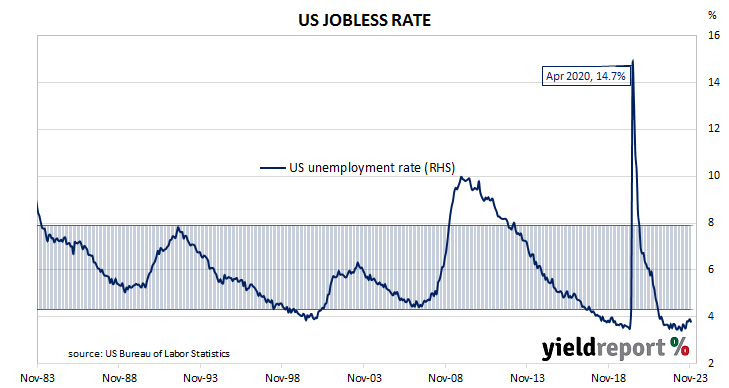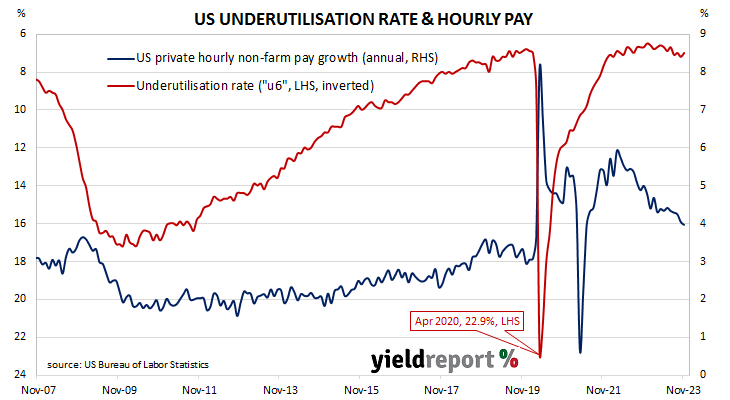Summary: US non-farm payrolls up 199,000 in November, in line with expectations; previous two months’ figures revised down by 35,000; jobless rate falls to 3.7%, participation rate ticks up to 62.8%; ANZ: recent months’ growth well above level associated with price stability; employed-to-population ratio rises to 60.5%; underutilisation rate down; annual hourly pay growth steady at 4.0%.
The US economy ceased producing jobs in net terms as infection controls began to be implemented in March 2020. The unemployment rate had been around 3.5% but that changed as job losses began to surge through March and April of 2020. The May 2020 non-farm employment report represented a turning point and subsequent months provided substantial employment gains which continued through into 2021 and 2022. Changes in recent months have been generally more in line with the average of the last decade.
According to the US Bureau of Labor Statistics, the US economy created an additional 199,000 jobs in the non-farm sector in November. The increase was in line with consensus expectations but more than the 150,000 jobs which had been added in October. Employment figures for October and September were revised down by a total of 35,000.
“The three-month average of 204,000 is well above the 150,000 long-run level often associated with price stability,” said ANZ FX analyst Felix Ryan.
The total number of unemployed decreased by 215,000 to 6.291 million while the total number of people who were either employed or looking for work increased by 532,000 to 168.260 million. These changes led to the US unemployment rate falling from October’s figure of 3.9% to 3.7% while the participation rate ticked up from 62.7% to 62.8%.
US Treasury yields rose significantly on the day, especially at the short end. By the close of business, the 2-year yield had gained 13bps to 4.72%, the 10-year yield had added 9bps to 4.23% while the 30-year yield finished 6bps higher at 4.31%.
In terms of US Fed policy, expectations of a lower federal funds rate in the next 12 months softened. At the close of business, contracts implied the effective federal funds rate would average 5.33% in December, in line with the current spot rate, 5.34% in January and 5.285% in March. November 2024 contracts implied 4.425%, 90bps less than the current rate.
One figure which is indicative of the “spare capacity” of the US employment market is the employment-to-population ratio. This ratio is simply the number of people in work divided by the total US population. It hit a cyclical-low of 58.2 in October 2010 before slowly recovering to just above 61% in late-2019. November’s reading rose from 60.2% to 60.5%, still some way from the April 2000 peak reading of 64.7%.
Apart from the unemployment rate, another measure of tightness in the labour market is the underutilisation rate and the latest reading of it registered 7.0%, down from 7.2% in October. Wage inflation and the underutilisation rate usually have an inverse relationship; hourly pay growth in the year to November remained steady at 4.0% after revisions.



